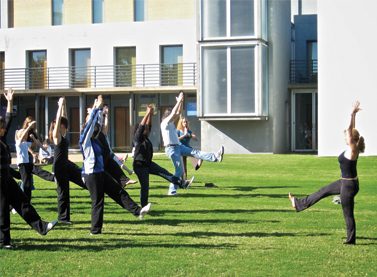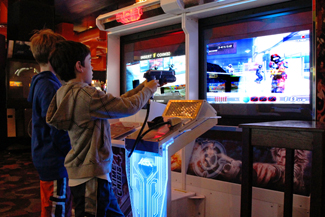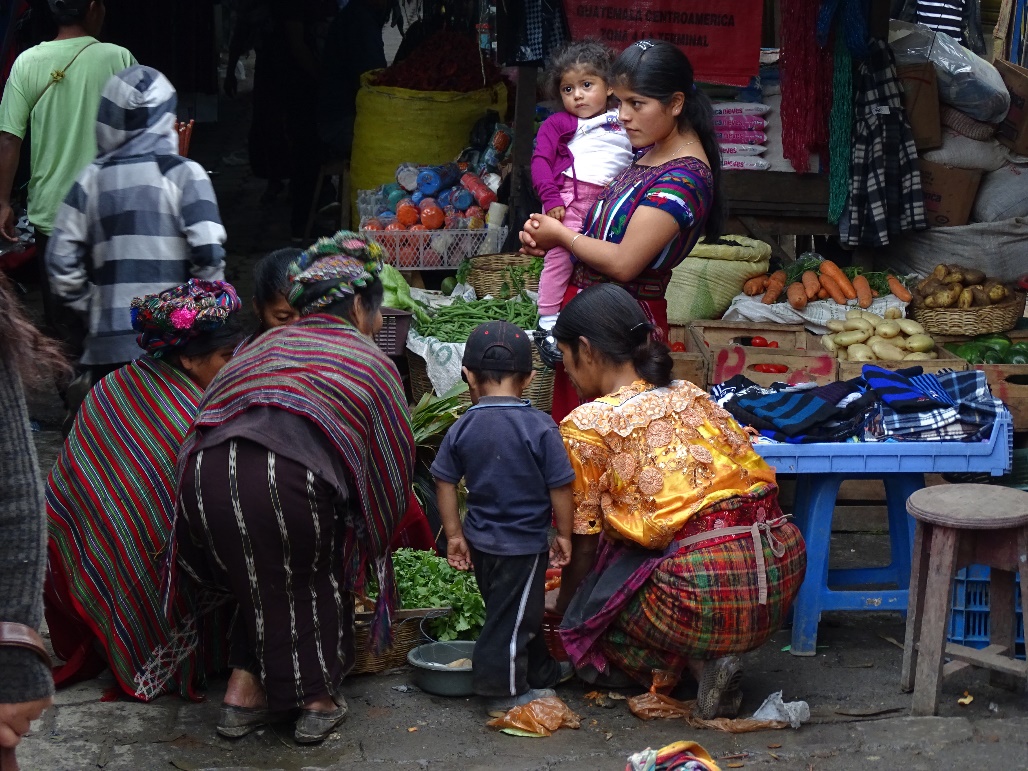41 6.4. Observational Learning (Modeling)
Previous sections of this chapter focused on classical and operant conditioning, which are forms of associative learning. In contrast, in observational learning, we learn by watching others and then imitating what they do or say. For instance, have you ever gone to YouTube to find a video when you need to figure out how to do something? The individuals performing the action in the video are called models. We often use instructors in exercise or yoga classes as models too (see Figure 6.12). Research suggests that this imitative learning involves a specific type of neuron in our brains, called a mirror neuron (Hickock, 2010; Rizzolatti et al., 2002; Rizzolatti et al., 2006). Mirror neurons help us to know if we are performing an action correctly. For example, we may have some mirror neurons that fire when we watch someone jumping rope—these same neurons will fire when we jump rope ourselves. In other words, they respond both to specific actions and observation of that action, and can help us to learn if we are correctly copying the actions we observe.
Humans and other animals frequently engage in observational learning. For example, Yamamoto and colleagues in a study of social learning in chimpanzees, gave juice boxes with straws to two groups of chimpanzees. Some of the chimps dipped the straw into the juice box, and then sucked on the small amount of juice at the end of the straw. Others sucked through the straw directly, getting much more juice. When the “dippers,” observed the “suckers,” they quickly switched to sucking through the straws directly. Simply observing the other chimps and modeling their behavior, helped them to learn that this was a more efficient method of getting juice (Yamamoto et al., 2013).
Link to Learning
Are chimps smarter than children? Watch this video showing chimps and children performing tasks and contemplate who performed the task better. How about quicker? Why do you think that they behaved in such different ways with the transparent box?
Psychologist Albert Bandura and other researchers proposed a brand of behaviorism called social learning theory, which acknowledged the importance of cognitive processes for learning. Like Tolman, Bandura felt that pure behaviorism could not explain why learning can take place in the absence of external reinforcement. He felt that internal mental states must also have a role in learning.

Of course, we don’t learn a behavior simply by observing a model. Bandura described specific steps in the process of modeling that must occur for learning to be successful: attention, retention, reproduction, and motivation. First, you must pay sufficient attention to notice all the different aspects of the behavior that you are observing. Next, you must be able to retain, or remember, what you observed. Third, you must be able to physically perform the behavior that you observed and committed to memory. Finally, you must have motivation for modeling the behavior. Bandura showed that if a model is reinforced for their behavior, this increases the motivation for others to copy them. This is known as vicarious reinforcement. On the other hand, if you vicariously observe a model being “punished—or having an unpleasant consequence to their behavior, you would be less motivated to copy them. This is called vicarious punishment. Vicarious punishment can help us from making the same mistakes as other people, for example, we can learn to avoid touching objects (like a stove) that could burn us if we see someone else do it first.
Some of Bandura’s research focused on how children modeled aggressive and violent behaviors they saw in adults (Bandura et al., 1961). Bandura conducted an experiment with a five-foot inflatable doll that he called a Bobo doll. Children watched an adult referred to in the study as a “teacher” interacting with the doll. In one scenario, the teacher acted aggressively with the doll, hitting, throwing, and even punching the doll, while a child watched. When the teacher was punished for their bad behavior, the children decreased their tendency to act as the teacher had. When the teacher was praised (or not punished) for his behavior, the children imitated what they did, and even what they said. The children punched, kicked, and yelled at the doll. In a later similar study, Bandura showed that the children’s behavior could be modified by offering them incentives to copy what they had seen. When given juice and candy, even children who had watched the adult being punished (with a scolding and a spanking) imitated the behavior just as much as the other groups of children (Bandura, 1965).
Link to Learning
Watch this video clip about the famous Bobo doll experiment to see a portion of the experiment and an interview with Albert Bandura.
What are the implications of Bandura’s Bobo doll study? Bandura concluded that we watch and learn, and that this learning can have both prosocial and antisocial effects. Prosocial models can be used to encourage socially acceptable behavior. For example, children can be encouraged to read, if others read to them. And if they see other people reading (and enjoying it). Children who live in collectivistic societies see how people in their community help each other and follow suit. Who have been the most effective prosocial models in your life?
The antisocial effects of observational learning are also worth mentioning. Children who are victims of violence are more likely to be violent as adults (Widom, 1989; Murrell et al., 2007). In fact, about 30% of child abuse victims become abusive parents (U.S. Department of Health & Human Services, 2013). Children who grow up witnessing their parents deal with anger and frustration through violent and aggressive acts sometimes learn to behave in that manner themselves. It is important to note however, that the majority of people who experience abuse and neglect as children, do not show the same behaviors toward their own children.
Multiple studies suggest that violent television shows, movies, and video games may also have antisocial effects on children (Anderson & Gentile, 2008; Kirsch, 2010; Miller et al., 2012). These findings may not be surprising, given that a child graduating from high school has been exposed to around 200,000 depictions of violent acts including murder, robbery, torture, bombings, beatings, and rape through various forms of media (Huston et al., 1992). Viewing media violence can model aggressive behavior, thus encouraging people to act that way in real life situations, but it has also been suggested that repeated exposure to violent acts can desensitize people to its impact. Psychologists are working to understand this dynamic (Figure 6.13).

Link to Learning
View this video about the connection between violent video games and violent behavior to learn more.
What Do You Think?
Violent Media and Aggression
Does watching violent media or playing violent video games cause aggression? Albert Bandura’s early studies suggested television violence increased aggression in children, and more recent studies support these findings. For example, research by Craig Anderson and colleagues (Anderson et al., 2015; Anderson et al., 2010; Bushman et al., 2016) found extensive evidence to suggest a causal link between hours of exposure to violent media and aggressive thoughts and behaviors. However, studies by Christopher Ferguson and others suggests that while there may be a link between violent media exposure and aggression, research to date has not accounted for other risk factors for aggression including mental health and family life (Ferguson, 2011; Gentile, 2016). What do think? What are some of the ethical issues around conducting experiments on exposure to violence in children?
The extent to which children rely on observational learning varies widely across cultures, which in turn contributes to cultural differences in the efficacy of this type of learning (Rogoff et al., 2011). Children from indigenous cultures (e.g., Mayans from Mexico and Guatemala) are frequently present as the adults around them work and engage in social activities. They have multiple opportunities to learn by observing interactions between others in their daily lives (see Figure 6.14). Indigenous children frequently perform simple chores and participate in other community activities from an early age. In contrast, most young children from middle-class Euro-American families spend most of their day apart from adults engaged in child-centered activities (e.g., in preschool settings). Children exposed to indigenous practices are more likely to pay greater attention to a number of activities at the same time, and so are able to reproduce the behaviors that they observe more accurately than their non-indigenous counterparts. Rogoff and colleagues conducted studies with Mayan children exposed to indigenous practices and middle-class European American children. Each child was told that they were going to be shown how to make an origami figure and were given a toy to distract them. At the same time, their sibling was being shown how to make a different toy at another table. Video recording showed that the Mayan children (but not the Euro-American children) paid close attention to what their sibling was doing. A week later, only the Mayan children were able to create the toy they had seen their sibling make, with relatively little assistance (Rogoff et al., 2011).

